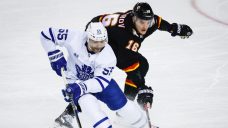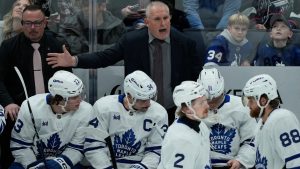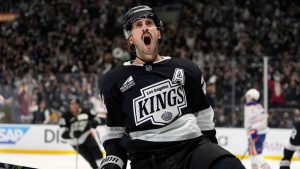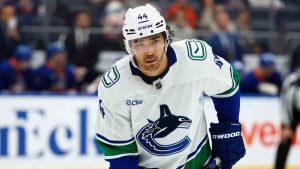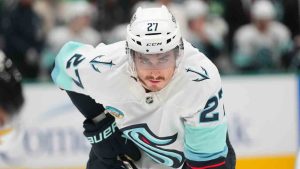When Toronto Maple Leafs head coach Sheldon Keefe stood up to take questions after the loss to the Ottawa Senators on Wednesday night, he was hot. He’s a thoughtful guy, and is generally careful when choosing his words, but he’s also not so great at hiding when he’s on tilt, and so the internal battle between those forces played out in real time as he took questions.
In his more composed moments he managed to get across the sentiment “we need to be better” with statements like: “The team and cohesion of the group, the process that you play with, should take care of everybody. That is where we have been disconnected at times.”
The implicit idea shared there is just about the only one the coach is allowed to share, which is that if everyone commits a little more to defence and team structure, they can be better and get this thing going in the right direction. I say it’s the only thing he can share because he’s the coach, not the GM, so saying “Our team does not have good enough defensive players to defend well consistently” is a direct call-out and probably gets you fired.
In theory, Keefe is right. Some better commitment to details from his forwards in the D-zone would help.
Meanwhile, a GM should be trying to get talent, because every player can defend – it’s not some unique set of talents only special athletes have – and so it’s up to the coach to get those talented players to play defence. You get the skill, the coach shows them how to operate without the puck, you benefit from the skill at the offensive end.
The problem with this logic is that not every player is willing to adapt to a defence-and-team-first mindset, as much as it’s been preached. Not just now, but some players never get there. You can spend every practice leading horses to water, but they may choose to never drink.
So maybe the desperation and fever pitch in the city pushes the Leafs forwards to defend as a priority. But if these offensive leopards just haven't been that type over their careers, it's unlikely they'll suddenly change their spots.
As noted, anyone can defend, but if a player isn't wired that way, they're going to stray.
Another important note to pair with that: Players on one-year contracts are not incentivized to do it. Offence gets you paid.
If Max Domi sacrifices five points this season to make defence-first decisions, he'll make less money next year, because people will sign him based on his ability to create depth scoring and those numbers will be lower. John Klingberg is incentivized to earn his next deal based on points (he’s an offensive defenceman, isn’t he?), so is Tyler Bertuzzi, and even a guy like Noah Gregor knows if he can get to 10 goals it will guarantee him another NHL one-way.
Try being a fringe player holding up “was good in the team structure, I swear” to 31 other GMs in the summer.
This Toronto Maple Leafs group was put in a roster construction bind by Kyle Dubas that basically says “We’re going to pay our stars a lot to keep them and the advantage that comes with it; the trick will be filling in the holes with value-plus players.” Then the keys got handed to Brad Treliving, who was forced to use that team construction method, and frankly, missed on just about every off-season deal save for re-signing Auston Matthews. Almost every new player (except Gregor who isn’t used much) has been negative value to their contract.
So the coach is going to work himself grey(er) trying to get this group to play defence, as the stats show this Leafs team is worse in just about every conceivable way there.
In 2022-23, the Leafs led the NHL in scoring chance differential, a stat most coaches care a ton about. They were, on average, plus-2.67 chances better than their opponents last season. This season, they’re 27th at minus-0.92, a number that’s largely shaped by them going from giving up 8.9 chances against per game, to 11.8.
This isn’t because they’re being coached differently. The core has always been just-OK defensively (Mitch Marner and Matthews can both be great defenders when committed), and so a lot of that burden has been generally, and rightfully, handed to what’s essentially a subordinate class of Leafs.
Look at the difference in the guys they brought in, compared to those who left.
And for those players coming "in" this season who’ve only played on bad teams, well, that’s at least a bit relevant too.
Here's the “out” list:
Alex Kerfoot
Sam Lafferty
Noel Acciari
Michael Bunting
Ryan O’Reilly
And the “in” list:
Tyler Bertuzzi
Max Domi
Ryan Reaves
Noah Gregor
(The Leafs also added rookie Matthew Knies, who’s learning to defend at the NHL level.)
When we look at the defensive careers (focusing on the past three seasons) of the forwards the Leafs let go of in the off-season, compared to the players they brought in, it's about what you’d expect. Yes, the Leafs have been a good team over those years, which helps their numbers. But those players contributed to that success (and a few of them did it in other places anyway).
Stats comparing those groups over the past three years are below. Expected-goals-for percentage is at even strength, and shorthanded TOI is included to demonstrate how their coaches valued their defensive abilities. The stats shown as “rates” are per 60 minutes of ice time.
(Stats courtesy SportLogiq)
You would think the new forwards who’ve largely been on worse teams (Bertuzzi was mostly in Detroit, Gregor San Jose, Domi in Chicago and Columbus), would spend more time in the D-zone and therefore block more shots, have the chance to win more loose pucks, and block more passes. But nope, that did not turn out to be the case.
Simply put, this is a group of forwards who are not wired to protect the house, which is why Keefe – in those same post-Ottawa comments – said some things like “This is different than some of the things we have gone through in the past. The group has to really pull together here.”
Compared to previous years, it is much less “in this group” for it to come together.
And while the blue line defence is much harder to calculate as a group (figuring out who to count as in/out is a little subjective), the rates for “expected goals for percentage” from Klingberg, William Lagesson, and Simon Benoit is 46.5 per cent, while Justin Holl, Luke Schenn, and Erik Gustafsson totalled 51.3 per cent on their way out.
It’s pretty clear this year's group is worse there, too.
I realize it’s all much simpler than this to some people. Last year the Leafs' goalies finished 10th in team save percentage and this year they sit at 25th. That obviously matters a great deal, but as you saw above, they’re seeing way worse defending in front of them, and I do think those things are related. Maybe because Ilya Samsonov is busier he has less energy to make those glorious high danger saves, a statistic in which he’s fallen from first in the league to 46th this season (all-strengths).
Over the past few years, the Leafs' “defensive problems” were some sort of oft-cited urban legend, greatly talked about but nowhere to be seen in reality. They were seventh in goals against last season while Vegas, the eventual Cup winner, was 11th.
This is a long and winding way of saying that this Leafs team, as currently constructed, needs some combination of buy-in from its useful new players they may want to keep, and the new bodies they maybe don't.
Defensively, you’re only as good as your weakest link, and between Klingberg and Ryan Reaves, the Leafs are hemorrhaging goals against. Simply replacing them with league average players would help the team’s defence – that would be a start.
Convincing guys like Domi and Gregor that offence isn't going to be what keeps them relevant in Toronto or for their next NHL contract, but defensive play will, is a tough sell that Keefe has to make. The easiest way to get there is by promising ice time to those who show the requisite commitment.
More than any other year, a turnaround for Toronto's team defence is not promised. The GM has to act boldly (cutting ones losses isn’t easy), and the coach has to do his best sales job yet, or Brendan Shanahan’s dream of winning a Stanley Cup with this “core four” will have to be given up on at some point.
That’s a bigger discussion for another day, but the parting of a star for defensive assets is the conversation that waits on the other side if the Leafs continue to struggle to keep pucks out of their net.

